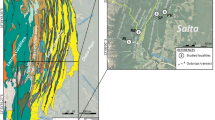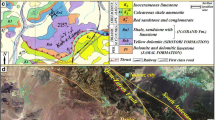Abstract
The current work attempts to address a century old problem regarding the stratigraphic disposition of the Upper Gondwana succession of the Rewa basin based on geological mapping and litholog preparation along well exposed transects. The proposed Upper Gondwana stratigraphy of the Rewa basin comprises a continuous and thick package of Triassic sediments unconformably overlain by the Jurassic Parsora Formation. The Triassic succession consists of a basal Pali Formation, an intermediate and newly designated Karki Formation and the overlying mud-dominant Tiki Formation. These formations are well defined based on physical attributes such as lithology, textures and sedimentary structures, and are easily distinguishable in the field. Based on stratigraphic correlation and fossil content, a Lower-Middle Triassic age has been assigned for the Pali and Karki formations, while the Tiki Formation is Upper Triassic (Carnian) in age. Preliminary observations based on lithological characteristics, sand body geometry and sand: mud ratios suggest that within a fluvial setting there were considerable changes in environments of deposition through time, especially during Triassic to Jurassic transition.
Similar content being viewed by others
References
Aigner, T. and Bachmann, G.H. (1992) Sequence-stratigraphic framework of the German Triassic. Sediment. Geol., v.80, pp.115–135.
Bandyopadhyay, S. and Sengupta, D.P. (2006) Vertebrate faunal turnover during the Triassic-Jurassic transition: an Indian scenario. In: Harris et al. (Eds.), The Triassic-Jurassic Terrestrial Transition. New Mexico Mus. Nat. Hist. Sci. Bull., v.37, pp.77–85.
Benton, M.J. (1983) The Triassic reptile Hyperodapedon from Elgin: functional morphology and relationships. Phil. Trans. Roy. Soc. London, v.B302, pp.605–717.
Bharadwaj, D.C. and Tiwari, R.S. (1977) Permian-Triassic miofloras from the Raniganj Coalfield, India. Paleobotanist, v.24, pp.26–49.
Blakey, R.C. and Gubitosa, R. (1984) Controls of sandstone body geometry and architecture in the Chinle Formation (Upper Triassic) Colorado Plateau. Sediment. Geol., v.38, pp.51–86.
Bose, M.N., Taylor, E.L. and Taylor, T.N. (1990) Gondwana floras of India and Antarctica — a survey and reappraisal. In: T.N. Taylor and E.L. Taylor (Eds.), Antarctic Paleobiology, Chapter 10. Springer-Verlag, New York, pp.118–148.
Chatterjee, S. (1978) A primitive parasuchid (Phytosaur) reptile from the Upper Triassic Maleri Formation of India. Paleontology, v.21, pp.83–127.
Chatterjee, S. (1980) Malerisaurus, a new eosuchian reptile from the Late Triassic of India. Phil. Trans. Roy. Soc. London, v.B291, pp.163–200.
Chatterjee, S. and Mazumdar, P.K. (1987) Tikisuchus romeri, a new rauisuchid reptile from the Late Triassic of India. Jour. Paleont., v.61, pp.787–793.
Collinson, J.D. and Thompson, D.B. (1994). Sedimentary Structures. CBS Publishers and Distributors, India.
Cotter, G. and De P. (1917) A revised classification of the Gondwana system. Rec. Geol. Surv. India, v.48, pp.23–33.
Datta, P.M. (2004) A suggestion for an early Tuvalian time segment for the Tiki Formation, South Rewa Gondwana basin, India and other correlatable continental sequences. Albertina, v.30(suppl), pp.6–7.
Datta, P.M. (2005) Earliest mammal with transversely expanded upper molar from the Late Triassic (Carnian) Tiki Formation, South Rewa Gondwana basin, India. Jour. Vert. Paleont., v.25, pp.200–207.
Datta, P.M. and Das, D.P. (1996) Discovery of the oldest mammal from India. Ind. Minerals, v.50, pp.217–222.
Datta, P.M. and Ray, S. (2006) Earliest lizard from the Late Triassic (Carnian) of India. Jour. Vert. Paleont., v.26, pp.795–800.
Datta, P.M., Das, D.P. and Luo, Z.X. (2004) A Late Triassic dromatheriid (Synapsida: Cynodontia) from India. Ann. Carn. Mus., v.73, pp.72–84.
Dutta, P.K. (2002) Gondwana lithostratigraphy of the peninsular India. Gondwana Res., v.5, pp.540–553.
Dutta, P.K. and Ghosh, S.K. (1972) Triassic sedimentation in Pali-Tiki-Parsora area, Madhya Pradesh. Proc. 49th Ind. Sci. Cong., Abstract volume, pp.232–233.
Dutta, P.K. and Ghosh, S.K. (1993) The century old problem of Pali-Parsora-Tiki stratigraphy and its bearing on the Gondwana classification of peninsular India. Jour. Geol. Soc. India, v.42, pp.17–31.
Fox, C.S. (1931). The Gondwana system and the related formations. Mem. Geol. Surv. India, v.58, pp.1–177.
Fox, C.S. (1934) Lower Gondwana coalfield of India. Mem. Geol. Surv. India, v.59, pp.386.
Friend, P.F., Raza, M., Geehan, G. and Sheikh, K.A (2001) Intermediate-scale architectural features of the fluvial Chinji Formation (Miocene), Siwalik Group, northern Pakistan. Jour. Geol. Soc. London, v.158, pp.163–177.
Gradstein, F.M., Ogg, J. and Smith, A.B. (2004) A Geologic Time Scale. Cambridge University Press, Cambridge, UK.
Hofmann, A., Tourani, A. and Gaupp, R. (2000) Cyclicity of Triassic to lower Jurassic continental red beds of the Argana Valley Morocco: implications for palaeoclimate and basin evolution. Paleogeog. Paleoclimat. Paleoeco., v.161, pp.229–266.
Hughes, T.W.H. (1881) Notes on the South Rewa Gondwana basin. Mem. Geol. Surv. Indis, v.14, pp.1–103.
Kent, D.V. and Olsen, P.E. (2000) Magnetic polarity stratigraphy and paleolatitude of the Triassic — Jurassic Blomidon Formation in the Fundy basin (Canada): implications for Early Mesozoic tropicalclimate gradients. Earth Planet. Sci. Lett., v.179, pp.311–324.
Lucas, S.G. (1998) Global Triassic tertapod biostratigraphy and biochronology. Paleogeog. Paleoclimat. Paleoeco., v.143, pp.347–384.
Maheswari, H.K. and Kumaran, K.P.N. (1979) Upper Triassic Sporae Dispersae from the Tiki Formation 1: Miospores from the Son River Section between Tharipathar and Ghiyar, South Rewa Gondwana Basin. Paleontographica, v.B71, pp.1–126.
Mitra, N.D. (1993) Stratigraphy of Pali-Parsora-Tiki Formations of South-Rewa Gondwana Basin and Permo-Triassic boundary problem. In: Dutta, K.K. and Sen, S. (Eds.), Gondwana Geology Magazine, Special vol., pp.41–48.
Mukhopadhyay, G., Mukhopadhyay, S.K., Roychowdhury, M. and Parui, P.K. (2010) Stratigraphic correlation between different Gondwana basins of India. Jour. Geol. Soc. India, v.76, pp.251–266.
Pascoe, E.H. (1975) A Manual of the Geology of India and Burma. Government of India Press, Calcutta, v.II(3), pp.909–1016.
Rao, C.N. and Sukla, R.N. (1954) Examination of the Supra Barakars around Parsora-Tiki tract in Shahdol District, Madhya Pradesh. Geol. Surv. India, Progress Report for the FS 1953-54, pp.1–54.
Retallack, G.J., Veevers, V.J. and Morante, R. (1996) Global coal gap between Permian-Triassic extinction and Middle Triassic recovery of peat forming plants. GSA Bull., v.108, pp.195–207.
Robinson, P.L. (1970) The Indian Gondwana formations — a review. First International symposium on Gondwana Stratigraphy. IUGS, South America, pp.201–268.
Ruffell, A. and Shelton, R. (1999) The control of sedimentary facies by climate during phases of crustal extension: examples from the Triassic of onshore and offshore England and Northern Ireland. Jour. Geol. Soc., London, v.156, pp.779–789.
Sahni, M.R. and Rao, C.N. (1956) A note on the correlation of the Parsora and Tiki Beds of Vindhya Pradesh, Proc. 20th Int. Geol. Cong., Mexico, pp.95–103.
Sarkar, S. (1988) Petrology of caliche-derived peloidal cacirudite/calcarenite in the Late Triassic Maleri Formation of the Pranhita-Godavari valley, south India. Sediment. Geol., v.55, pp.263–282.
Sengupta, D.P. (1992) Metoposaurus maleriensis Roy Chowdhury from the Tiki Formation of Son-Mahanadi Valley of Central India. Indian Jour. Geol., v.6, pp.41–65.
Sengupta, D.P. (2002) Indian metoposaurid amphibian revised. Paleont. Res., v.6, pp.41–65.
Shah, B.A. (2000) Revision of age of Parsora Formation from plant assemblages in Karkati area, Johilla-Son valley, Rewa basin, M. P. Indian Minerals, v.54, pp.223–232.
Shah, B.A. (2001) Fluvial sedimentation of Tiki-Hartala formations (Triassic-Jurassic) in a part of Johilla-Son Valley, Rewa basin, MP. Indian Jour. Geol., v.72, pp.93–106.
Shah, B.A. (2004) Gondwana lithostratigraphy of peninsular India. Gondwana Res., v.7, pp.600–607.
Sukh Dev (1987) Floristic zones in the Mesozoic formations and their relative ages. Paleobotanist, v.36, pp.161–167.
Tarafdar, P., Sinha, P.K., Das, K.P., Kundu, A., Dutta, D.R., Rajaiya, V., Parui, P.K., Patel, M.C., Thanavelu, C., Kumar, A., Pillai, M.K., Agasty, A. and Dutta, N.K. (1993) Recent advance in Post-Barakar stratigraphy in parts of Rewa Gondwana Basin. Gondwana Geol. Mag., Spec. Vol., pp.60–69.
Veevers, J.J. and Tiwari, R.C. (1995) Gondwana master basin of peninsular India between Tethys and interior of Gondwanaland Province of Pangea. Geol. Soc. Amer., v.187, pp.1–73.
Vimal, K.P. and Singh, S.N. (1968) Plant fossils from Karkati in the South Rewa Gondwana basin, India. Jour. Palaeont. Soc. India, v.5, pp.34–38.
Author information
Authors and Affiliations
Corresponding author
Rights and permissions
About this article
Cite this article
Mukherjee, D., Ray, S., Chandra, S. et al. Upper gondwana succession of the Rewa Basin, India: Understanding the interrelationship of lithologic and stratigraphic variables. J Geol Soc India 79, 563–575 (2012). https://doi.org/10.1007/s12594-012-0096-x
Received:
Accepted:
Published:
Issue Date:
DOI: https://doi.org/10.1007/s12594-012-0096-x




